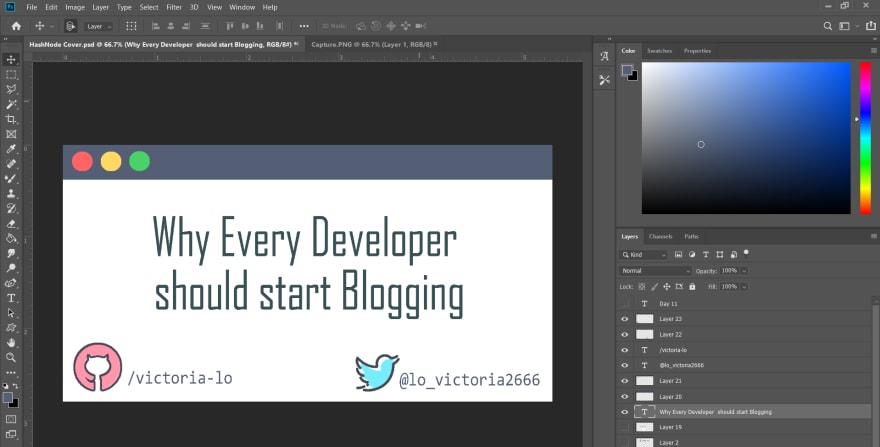
Victoria Lo
Posted on December 29, 2020
In this article, I'll be sharing the process of how I write blog articles and publish them on various platforms. I have been asked how I stayed consistent in my writing and my simple answer to that is:
PLANNING. A lot of it.
So let me explain how I plan with my very ordinary writing process: draft -> write -> publish*. **Then, I will include some **useful blogging tips* that works personally for me when I got started with writing.
*Disclaimer: this is my personal writing process. It does not mean it's good/perfect because everyone has their own work style and habits :) *
Step 1: Brainstorm Ideas
For every type of content creation - video, audio or written content, brainstorming is the very first step to take. Ideas usually come and go, so I would quickly pen it down whenever a light bulb glows above my head.
I use Sticky Notes, a default post-it note app in my laptop. I would write the working title of the idea and some main points I'd like to write about.
Then, let the ideas incubate for a day or more before coming back to revise it. At this stage, some ideas get thrown away and some gets further explored/developed.
Idea Incubation: the process of leaving an initial idea or solution for a period of time by not consciously thinking about it.
Step 2: Create Cover Art
If the idea passed the incubation stage, I proceed to create its cover art. I am aware people usually do this step after they have written the article but personally, I like having fun with designing a nice cover art first.
That way, since I've already spent time making a cover art for it, I will remind myself to finish the article and not abandon it. I'm simply using the sunk cost fallacy to my advantage as an additional motivation haha.
Sunk Cost Fallacy: committing to a behaviour due to resources (i.e. time) already spent.
Step 3: Skeleton Table of Contents
After creating the cover art, I will create a new draft on Hashnode, insert in the working title, tags and type a skeleton structure of the topic I plan to write. This helps me organize the flow and focus on only the relevant points in the article.
In this stage:
- Break down the main topic into organized headings
- Break headings down further sub-headings if needed
- Add pictures or other details (like quotes) that helps visualize/summarize what the topic is about
The image above is an example of what a skeleton draft looks like. It is only a draft and likely to be revised a lot of times before publishing. Usually, after creating this minimal draft, I close the tab or work on another draft article. After all, a new draft for me is non-urgent (to be published in 10 days or more).
Note: It's July 11 when I first initialize this article's draft.
Step 4: Progressing Slowly beyond Skeleton Draft
After making the skeleton draft, I would check and view the draft whenever I am free. That visual cue reminds me to write something, even if it is just a little. I will slowly make progress by spending just 5 to 20 minutes a day to add new words to the draft (and other drafts).
When asked, 'How do you write?' I invariably answer, 'one word at a time'. - Stephen King
Every time I published an article, I add new skeleton drafts to keep my Drafts populated. At the same time, I'm slowly progressing on the earlier drafts to be completed for publishing.
The image below shows an example of how my drafts look like with their estimated percentage completed and their estimated publishing date.
Rough Progression Percentage System:
- **1-9%: **Only title and cover art with tags. Minimal skeleton headings only.
- 10-19%: Organized skeleton headings, a few but undecided sub-headings with some details.
- 20-49%: Decent draft with organization, headings and sub-headings decided. Small paragraphs already written. Most are in point form.
- 50-69%: A good draft. Almost all paragraphs are written under each heading.
- 70-79%: A completed first draft. Open to possible changes. Spelling/grammar not checked.
- 80-89%: Revised and checked for spelling/grammar errors.
- 90-99%: Ready for publishing. Maybe some minor polishing needed.
Step 5: The Undisturbed Typing Phase
After a few days, a draft finally reached its 49% completion mark and things would start to get serious. The article would be due in 2 days or less, which means I need to start typing paragraphs and remove point forms.
This is when I allocate a block of time (i.e. 1-3 hours) to speed up the progress of the article.
In this step, I would proceed in the following:
1. Find a non-distracting environment
I would remove anything I find distracting, such as:
- phone
- food and beverages (water is okay)
- web/desktop app notifications (i.e. messenger, discord, etc.)
- bright lights
2. Fill in the gaps
At this stage, the draft has headings, sub-headings, short paragraphs and point forms of some details. Compared to a blank draft, it becomes rather easy to write by filling in the gaps and rephrasing the point forms into paragraphs.
This strategy is one used by the well-renowned author Stephen King himself to prevent writer's block. By having the draft 40-49% done, the rest is simply about adding more sentences into the outline. The more words you have written before this stage, the easier this process will be.
More ways to prevent/cure writer's block here.
3. Take only short breaks if necessary
Only water or restroom breaks are allowed in this time period. The momentum is crucial to keep writing till the end. At this point, I don't worry about spelling or grammar. I just aim to complete the article, with its content fully organized and readable.
Final Step: Polish, Proofread, Publish!
At this stage, the article should be around 75% complete. Congratulations! The first draft is complete. If there's time before the publishing date, I will take a break first then come back to this step later.
This step is pretty straightforward.
- Check for spelling/grammars errors: I use this browser extension
- Read 2-3 times to check if the flow makes sense
- Make sure all resources are cited (like images or any websites used for references)
- Code blocks are properly formatted and readable
- Headings and sub-headings are properly sized
- Publish according to schedule
Some Useful Tips for New Dev-Writers
And that's how an article is created from this laptop to publication! I'll leave you with some tips I found useful for this writing process. I'll try to keep it short.
Tip 1: Ideas come from reading and writing more
Many respectable authors like Agatha Christie, J.K Rowling and Jane Austen get inspirations from:
- Observing and understanding the world around them
- Reading on many topics that pique their interest/curiosity
- Exploring their passions and focusing on writing for themselves not others
- Writing a lot and gaining valuable feedback in the process
Tip 2: Don't publish daily, but consistently
- Publishing daily will wear you out very soon. So publish consistently instead.
- Let each article have their time to shine.
- Let more readers read the article before overwhelming them with a new content
- Set a publishing schedule and prepare for the next article to write during days when you don't publish
Tip 3: Reward yourself after completing a milestone
- Give yourself some free time, food, meeting friends, etc. after completing a draft or publishing an article
- Celebrate the little joys you have when writing because it keeps you intrinsically motivated
Tip 4: Progress slowly and steadily
Take your time to develop the habit to write. There's no rush here. Don't compare yourself to anyone.
Aim to write once a month, then once every 2 weeks then once a week. Progress at your own pace, as slowly as you want, as long as you don't stop.
"Success is the sum of small efforts, repeated day in and day out." - Robert Collier
Tip 5: Plan ahead
Typically, I would try to have 4-5 draft articles queued for publishing in my Drafts.
By the time this article is published, all my current drafts should have also been published and I would have 4-5 new draft articles in the back waiting. Of course, if you are still new at this, have 1 draft waiting instead.
"A man who does not plan long ahead will find trouble at his door." - Confucius
Thanks for reading!
I know this has been a long article, so I appreciate you for taking the time to read till the end. I hope you have found it helpful and motivational for you to start your writing journeys! Please like and share this article around if it helps you in any way. Cheers!

Posted on December 29, 2020
Join Our Newsletter. No Spam, Only the good stuff.
Sign up to receive the latest update from our blog.




